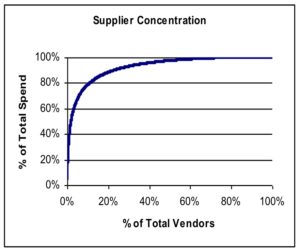American Red Cross Uses Amazon to Manage Tail Spend
“Tail spend” – the dreaded word that strikes fear into every procurement executive’s heart..for the uninitiated, this refers to the long “tail” in a Pareto chart, that includes the large number of suppliers that are small volume purchases, often for $1000 or less. The Pareto principle applies here: 80% of an organization’s spending is with 20% of the suppliers (and vice versa – 80% of the supply base constitute less than 20% of the spend!)
 Managing this category of suppliers is problematic, as in many cases the internal costs of getting them on a contract, adding the supplier to an approved supplier database, and processing the requisition, approval, invoice, and payment is greater than the value of the purchase itself! Further, the total number of suppliers in the tail can number in the thousands!
Managing this category of suppliers is problematic, as in many cases the internal costs of getting them on a contract, adding the supplier to an approved supplier database, and processing the requisition, approval, invoice, and payment is greater than the value of the purchase itself! Further, the total number of suppliers in the tail can number in the thousands!
This year, the American Red Cross have begun to utilize and will continue to migrate to Amazon Business, in lieu of their prior procurement card (p-card) process for low cost items. Amazon Business offers the conveniences most people have come to expect — fast, free flexible delivery options; easy price comparisons; and a large variety of products. Additionally, it offers business-only prices on millions of items with quantity discounts, an advanced analytics dashboard to monitor usage and spending, and a seamless approval and workflow process.
Access to Amazon Business is also being tied to the Red Cross’s migration to Coupa, which will replace Ariba in a phased rollout over the next six months. However employees, without access to Coupa can also place orders directly with their p-card via the Amazon Business website.
Benefits
Simplifying the procurement process for certain suppliers both lowers cost and mitigates risk for companies like the Red Cross, which counts over 30,000 suppliers in their “tail spend”. In turn, this helps the entire organization achieve alignment with their FY22 goals of efficiency, process and technology improvement, and people investment by:
- Assuring efficiency through Amazon’s two-day delivery at no additional cost;
- Achieving an average cost reduction of 15% on purchases;
- Ensuring tax-exempt status on purchases;
- Building a strategic partner relationship with Amazon;
- Enhancing user experience and IT security with single sign-on;
- Providing view into spend patterns for possible buying consolidation; and
- Managing “tail spend.” The Red Cross has 200 suppliers that make up 80% of its annual spend but, conversely, 30,000 plus suppliers make up the other 20% of our spending. Such a large amount of low dollar transactions (long tail spend) increases transactional risk and is costly to manage.
From a user experience, Coupa provides a “shopping cart” experience that aligns well with the Amazon experience that people have every day. The goal of the supply management team is to make it similar to an Amazon shopping experience. In fact, that was a key element of this business decision when selecting a new software platform.
Other organizations may want to explore similar approaches for managing the “dreaded” long tail spend problem.
- Categories:


